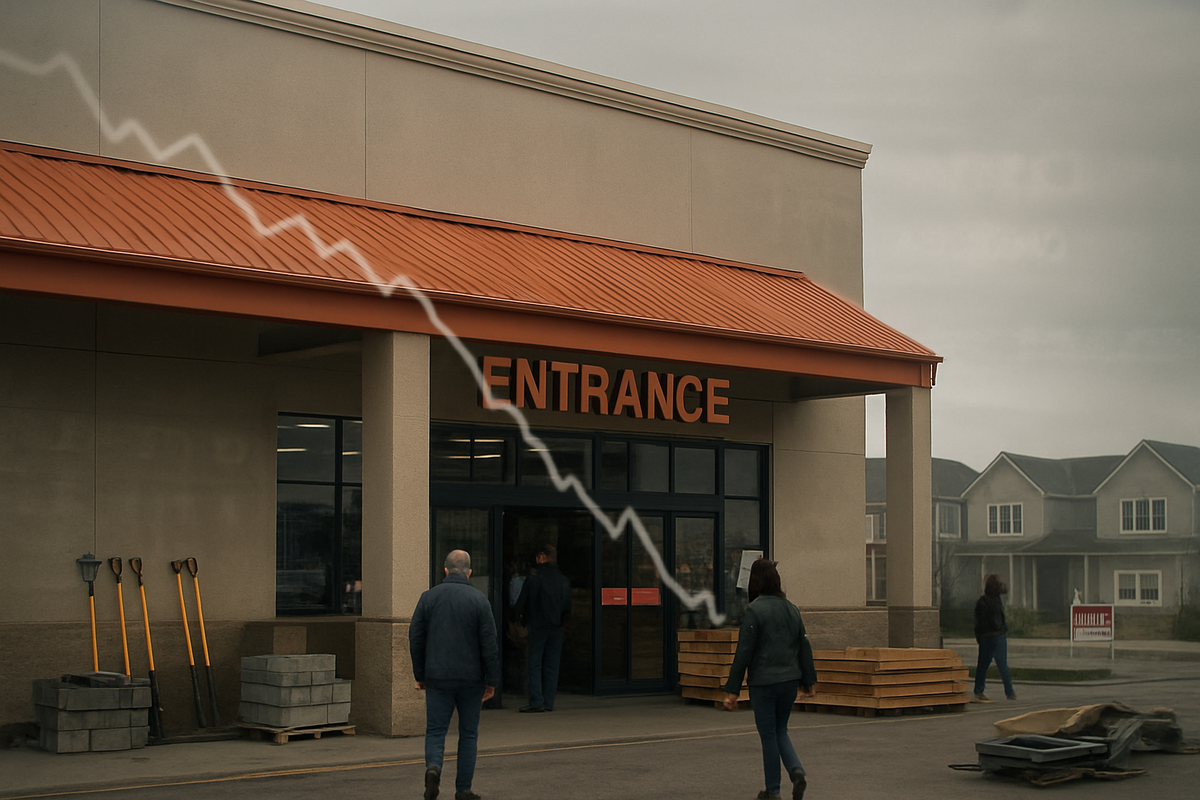
Home Depot (NYSE: HD), the world's largest home improvement retailer, delivered a significant blow to investor confidence today, November 18, 2025, reporting a third consecutive quarterly earnings miss for its fiscal third quarter of 2025. The news sent its shares tumbling in early trading, immediately casting a shadow over the broader retail sector and contributing to a palpable sense of unease in the overall stock market. This latest performance from a bellwether of consumer spending is being interpreted as a stark indicator of persistent economic headwinds, particularly a cooling housing market and cautious consumer behavior.
The earnings shortfall, primarily attributed by the company to a lack of severe weather events and ongoing consumer uncertainty, has triggered concerns that the slowdown in home improvement spending is more entrenched than previously anticipated. With higher borrowing costs and sticky inflation continuing to weigh on household budgets, consumers appear to be deferring large-scale renovation projects, a trend that could have far-reaching implications for not only Home Depot but also its competitors and the wider economy.
Home Depot's Q3 2025 Performance: A Deeper Dive into Disappointment
Home Depot's fiscal third-quarter report, released today, November 18, 2025, painted a challenging picture. The company reported adjusted earnings per share (EPS) of $3.74, falling notably short of analyst estimates that ranged between $3.81 and $3.95 per share. This figure also represented a slight decline from the $3.78 EPS recorded in the same period last year. While revenue managed to slightly exceed forecasts, coming in at $41.4 billion against consensus estimates of approximately $41.18 billion to $41.19 billion, the underlying metrics revealed significant weakness. Crucially, comparable sales, a vital measure of a retailer's health, increased by a mere 0.2% overall, substantially missing the anticipated rise of 1.3% to 1.36%. In the U.S., comparable sales barely edged up 0.1%, and customer transactions declined by 1.4%, signaling a clear reduction in store traffic, even as the average spend per visit saw a modest increase to $90.39.
This earnings miss marks Home Depot's third consecutive quarter of failing to meet profit expectations, highlighting a persistent struggle for the retail giant. The timeline of events leading up to this moment reflects an ongoing battle against a challenging economic environment. The company's recent acquisition of GMS Inc. contributed approximately $900 million to its revenue for about eight weeks of sales, but this influx was insufficient to offset the broader pressures. The earnings call today saw key players, including CEO Ted Decker, addressing the disappointing figures. Decker attributed the missed expectations primarily to an unseasonably quiet hurricane season, which led to lower demand in certain product categories typically boosted by storm-related repairs. He also acknowledged that while underlying demand remained relatively stable sequentially, the anticipated increase during the third quarter did not materialize, pointing to ongoing consumer uncertainty and a weak housing market as significant contributing factors.
The initial market reaction to Home Depot's announcement was swift and negative. Shares of Home Depot (NYSE: HD) experienced an immediate decline of approximately 1.8% to over 3% in pre-market and early Tuesday trading. This downturn placed the stock on a trajectory for a potential seven-month low and marked its worst one-day, post-earnings performance since February 21, 2023. The year-to-date loss for the stock through Monday prior to the report had already been around 8%, indicating pre-existing investor apprehension. The ripple effect was quickly felt across the sector, with shares of rival Lowe's Companies (NYSE: LOW), scheduled to report its own earnings the following day, falling by 2.9% in sympathy, underscoring collective investor concerns about the home improvement market.
In light of its third-quarter performance and the persistent challenges, Home Depot also updated its fiscal 2025 guidance. The company now expects total sales growth of approximately 3.0%, a slight increase from the previously projected 2.8%, primarily due to the GMS Inc. acquisition. However, comparable sales growth is now anticipated to be "slightly positive," a downgrade from the earlier forecast of approximately 1%. Most concerning for investors, adjusted diluted earnings-per-share are now projected to decline approximately 5.0% from fiscal 2024, a deeper contraction than the previous forecast of a 2% drop. These revised expectations reinforce the view that the company anticipates continued softness in the near term, impacting its profitability.
Ripple Effects: Winners and Losers in the Wake of Home Depot's Stumble
Home Depot's (NYSE: HD) disappointing earnings report today, November 18, 2025, reverberates far beyond its own stock, sending clear signals of a broader slowdown that will create both significant challenges and some unexpected opportunities across the retail and housing sectors. The core issue—a consumer "deferral mindset" on large discretionary home improvement projects, coupled with a "frozen" housing market and elevated interest rates—is reshaping the landscape for numerous public companies.
Unsurprisingly, direct competitors and companies deeply embedded in the home improvement supply chain are poised to be the primary losers. Lowe's Companies Inc. (NYSE: LOW), Home Depot's closest rival, experienced a sympathetic stock decline immediately after the announcement, indicating that investors anticipate similar headwinds for its upcoming earnings report. Both retailers are grappling with consumers pulling back on big-ticket items. Furthermore, building material manufacturers and suppliers, such as LL Flooring Holdings, Inc. (NYSE: LL) and Builders FirstSource, Inc. (NYSE: BLDR), are directly impacted by reduced demand for lumber, flooring, roofing, and other construction supplies. LL Flooring, already struggling with slowing home sales, filed for Chapter 11 reorganization in August 2024, highlighting the severe pressure in this segment. Home furnishings and appliance retailers like Big Lots Inc. (NYSE: BIG) and Conn's Inc. (NASDAQ: CONN) also face significant challenges, as fewer home sales and renovations translate directly into lower demand for new furniture and appliances. Many in this category have already seen store contractions or bankruptcies in 2024.
However, amidst the downturn, certain segments and companies may prove more resilient or even find avenues for growth. Home Depot itself is pivoting towards the professional (Pro) customer and the maintenance and repair sectors, a strategy that could benefit suppliers catering to this segment. The recent acquisition of GMS Inc., a specialty building products distributor, contributed positively to Home Depot's sales, underscoring the relative stability in the professional market for essential repairs and non-discretionary projects. Companies specializing in materials or services for smaller, high-ROI projects, such as certain bathroom or kitchen upgrades, might also see sustained demand as consumers opt for targeted improvements over full-scale renovations.
Moreover, the shift in consumer spending patterns suggests potential beneficiaries outside the traditional home goods sphere. If consumers are curtailing spending on home improvement goods, they are likely redirecting those discretionary funds elsewhere. This "pivot towards services" could benefit industries such as travel, hospitality, and entertainment, as individuals prioritize experiences over physical goods for their homes. Additionally, technology providers offering digital tools, supply chain enhancements, and AI solutions, like Home Depot's "Magic Apron AI," could find opportunities. As retailers seek to optimize operations, enhance customer experience, and drive efficiency in a challenging market, demand for such innovative solutions may remain robust, offering a silver lining for tech companies supporting the retail sector.
Wider Significance: A Barometer for Economic Health
Home Depot's (NYSE: HD) third consecutive earnings miss, announced today, November 18, 2025, is more than just a setback for a single retailer; it serves as a critical barometer for the health of the U.S. consumer and the broader economy. The company's performance and revised outlook underscore several pervasive industry trends and signal potential ripple effects that extend far beyond the home improvement aisle.
One of the most significant trends impacting the sector is the "lock-in effect" gripping the U.S. housing market. With many homeowners enjoying historically low mortgage rates, the incentive to sell and move has diminished, leading to the lowest home turnover rate in decades. This directly stifles demand for significant renovations, as new home sales typically catalyze extensive improvement projects. While national home values remain strong, providing homeowners with equity, the willingness to leverage that equity for large-scale, discretionary remodels is waning. High interest rates, even with the Federal Reserve expected to maintain stability around 3.75%-4% through 2025, make borrowing for such projects more expensive, further deterring consumers. This confluence of factors is driving a discernible shift towards smaller, "need-to-do" repair and maintenance projects over ambitious kitchen or bathroom overhauls, with planned household spending on renovations projected to drop to 2020 levels in 2025.
The ripple effects of Home Depot's performance are already being felt across its ecosystem. Competitors like Lowe's Companies (NYSE: LOW) are navigating the same challenging macroeconomic currents, as evidenced by its sympathetic stock decline. Suppliers of building materials, appliances, and home furnishings face reduced demand, potentially leading to inventory adjustments and increased price competition. Professional contractors and home service providers, while expected to see revenue growth in the coming years, must adapt to the prevailing trend of smaller-scale projects. Even the real estate sector is indirectly affected, as a less active housing market translates to fewer transactions that typically spur renovation spending.
Historically, the home improvement sector has proven to be highly cyclical and sensitive to economic conditions. The Great Recession of 2008-2009 saw a significant downturn in remodeling spending, demonstrating its close ties to the housing market's health. Similarly, periods of high interest rates in the early 1980s suppressed remodeling activity. Conversely, the pandemic-era boom (2020-2022) witnessed unprecedented growth, fueled by low interest rates and increased time at home. While the current dip is concerning, industry experts suggest it may be milder and shorter-lived than past downturns, with a "mild recovery" anticipated in late 2025 and a potential "Golden Age of Remodeling" in 2026-2027. This optimistic outlook is grounded in the underlying demand for maintaining an aging U.S. housing stock, suggesting that deferred projects could fuel future growth once economic conditions stabilize. Regulatory and policy implications primarily revolve around monetary policy, with the Federal Reserve's interest rate decisions being a key determinant, and trade policies that influence material costs.
What Comes Next: Navigating a Shifting Landscape
Home Depot's (NYSE: HD) recent earnings miss on November 18, 2025, sets the stage for a period of strategic recalibration for the retail giant and the broader home improvement sector. In the short term, the next 12-18 months will likely be characterized by continued challenges stemming from a "rate lock logjam" in the housing market, which continues to deter home sales and, consequently, pre- or post-move renovations. Consumers are expected to maintain their cautious approach to large, discretionary spending, prioritizing essential repairs and maintenance over ambitious remodels. This will likely keep Home Depot's profitability under pressure, with rival Lowe's Companies (NYSE: LOW) also facing similar headwinds. Economic volatility, including persistent inflation and rising material costs, will remain a significant concern, demanding agile supply chain management and competitive pricing strategies from retailers.
However, the long-term outlook, extending over the next 3-5 years, presents a more optimistic picture, driven by several powerful underlying trends. A substantial amount of pent-up remodeling demand is expected to be unleashed, fueled by an aging U.S. housing stock—with a median age of 43 years in 2023—that will increasingly require repairs and upgrades. The eventual stabilization and easing of interest rates, anticipated to begin by the second half of 2026, could unlock this deferred demand, potentially leading to a significant rebound in the repair and remodel sector, with double-digit growth projected by 2026. Demographic shifts, such as Baby Boomers "aging-in-place" and Gen Z entering the housing market, will also drive new waves of renovation needs, including demand for accessibility modifications, energy-efficient solutions, and smart home technology.
To capitalize on these future opportunities while navigating current headwinds, Home Depot must execute several strategic pivots. Reinforcing its professional (Pro) segment will be crucial; continued investments in digital tools, job site deliveries, bulk pricing, and dedicated Pro desks, as exemplified by the acquisition of GMS Inc., will solidify its position with contractors. Enhancing its digital and omnichannel experience to provide seamless online-to-in-store shopping journeys will be paramount for both DIY and Pro customers. Furthermore, adapting its product assortment and marketing to emphasize essential repairs and high-growth areas like energy efficiency, smart home solutions, and aging-in-place modifications will be vital. Proactive sustainability initiatives and a focus on long-term value will also resonate with evolving consumer preferences. The company's ability to remain agile in its supply chain and potentially address broader industry labor challenges through partnerships will also play a key role in its sustained success.
Comprehensive Wrap-up: A Test of Resilience
Home Depot's (NYSE: HD) earnings miss today, November 18, 2025, serves as a pivotal moment, underscoring the enduring challenges facing the home improvement retail sector and, by extension, the broader U.S. economy. The key takeaway is clear: while underlying demand for home maintenance and repair remains robust due to an aging housing stock, discretionary spending on large-scale renovation projects has been significantly curtailed. This slowdown is primarily driven by persistent consumer uncertainty, a "frozen" housing market hampered by high mortgage rates, and the absence of weather-related demand spikes. The company's revised, weaker full-year profit forecast confirms that these headwinds are not ephemeral but represent a more entrenched shift in consumer behavior and market dynamics.
Moving forward, the market will remain sensitive to macroeconomic indicators, particularly interest rates, housing market activity, and consumer confidence. While the short term promises continued volatility and cautious spending, industry experts largely anticipate a gradual recovery in late 2025, accelerating into 2026 and beyond. This rebound is predicated on the eventual easing of interest rates, which would unlock pent-up demand from homeowners currently hesitant to undertake major projects or move. The resilience of the professional (Pro) segment, coupled with the enduring DIY trend for smaller, essential tasks, will provide a baseline of stability, but significant growth will hinge on a broader economic revitalization.
The lasting impact of this period will likely be a more diversified and adaptive home improvement industry. Home Depot's strategic focus on its Pro customers, its continuous investment in omnichannel capabilities, and its exploration of high-growth niches like energy efficiency and smart home technology are not merely reactive measures but foundational shifts for long-term resilience. For investors, the coming months will demand close attention to Home Depot's forward guidance, particularly any insights into specific product categories and customer segments. Monitoring macroeconomic data, the performance of competitors like Lowe's Companies (NYSE: LOW), and the integration of strategic acquisitions will be crucial. While the immediate market reaction to an earnings miss can be sharp, long-term investors should evaluate whether current price dips present opportunities based on the company's fundamental strengths and its capacity to adapt to evolving market conditions.
This content is intended for informational purposes only and is not financial advice


















